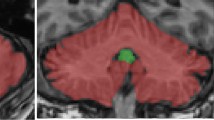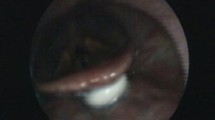Summary
Twenty-nine patients with moderate to severe tardive dyskinesia (TD) and 29 age-and sex-matched controls (C) with long-term neuroleptic therapy comparable to that of the patients were all examined using computeized tomography. Significant differences were found between the two groups in the width of the third ventricle (TD>C), the bicaudate distance (TD>C), the computed area of the head of the caudate nucleus (TD<C), and the area of the lenticular nucleus (TD<C). No significant differences were established in the ventricular or cella media indices. These results suggest that structural abnormalities, primarily in the basal ganglia system, are present in TD patients. Psychological testing with the Benton visual retention test also showed significant differences with regard to cerebro-organic functional impairment among TD patients.
Similar content being viewed by others
References
Christensen E, Møller JE, Faurbye A (1970) Neuropathological investigations of 28 brains from patients with dyskinesia. Acta Psychiatr Scand 46:14–23
Edwards H (1970) The significance of brain damage in persistent oral dyskinesia. Brit J Psychiat 116:271–275
Famuyiwa OO, Eccleston D, Donaldson AA, Garside RF (1979) Tardive dyskinesia and dementia. Br J Psychiatr 135:500–504
Gelenberg AJ (1976) Computerized tomography in patients with tardive dyskinesia. Am J Psychiat 133:578–579
Gross H, Kaltenbäck E (1970) Zur Neuropathologie der persistierenden choreiformen Hyperkinesen unter neuroleptischer Langzeittherapie. Psihofarmakologija (Zagreb) 2:195–204
Jellinger K (1977) Neuropathologic findings after neuroleptic longterm therapy. In: Roizin L, Shiraki H, Grecevic N (eds) Neurotoxicology, Raven Press, New York, pp 25–42
Jeste DV, Wyatt RJ (1981) Changing epidemiology of tardive dyskinesia: an overview. Am J Psychiatry 138/3:297–309
Jeste DV, Wagner RL, Weinberger DR, Rieth KGR, Wyatt RJ (1980) Evaluation of CT scans in tardive dyskinesia. Am J Psychiatry 137/2:247–248
Kameyama M, Yamanouchi H, Suda E (1975) Oral dyskinesia in the aged (in Japanese). Acta Geron Jpn 59:5–15
Neophytides AN, Dichivo G, Barron SA (1979) Computered axial tomography in Huntington's disease and persons at risk for Huntington's disease. In: Chase TN, Wesler NS, Barbean A (eds) Advances in Neurology, vol 23. Raven Press, New York, pp 185–191
Perris C, Dimitrijevic P, Jacobson L (1979) Tardive dyskinesia in psychiatric patiets treated with neuroleptics. Br J Psychiatr 135:509–514
Author information
Authors and Affiliations
Rights and permissions
About this article
Cite this article
Bartels, M., Themelis, J. Computerized tomography in tardive dyskinesia. Arch Psychiatr Nervenkr 233, 371–379 (1983). https://doi.org/10.1007/BF00346087
Received:
Issue Date:
DOI: https://doi.org/10.1007/BF00346087




